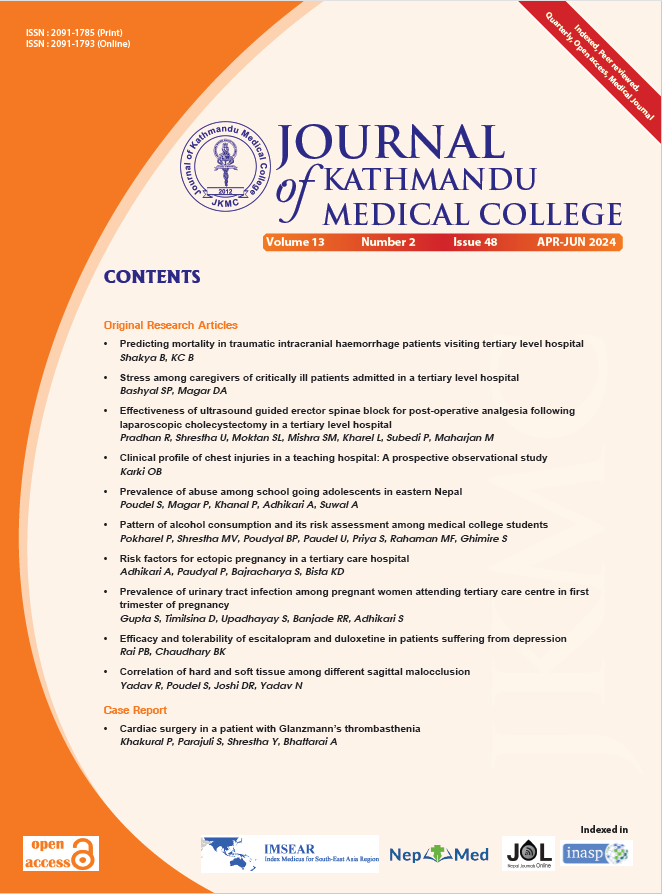Abstract
Introduction: Different people react differently to stress in difficult circumstances. Patients who are hospitalized in the critical care unit typically have major medical conditions. They may be unconscious or kept on artificial ventilation, which could be stressful for the caregivers.
Objective: To assess the stress among caregivers of critically ill patients.
Methodology: A descriptive cross-sectional study was conducted among 126 caregivers of critically ill patients using convenient sampling at Kathmandu Medical College and Teaching Hospital, Nepal. Data was collected using the Kingston Caregiver Stress Scale through face-to-face interviews and analyzed using descriptive (frequency, percentage, mean and standard deviation) and inferential statistics (chi square test, p value significant at ?0 05 level).
Result: The results showed that about two-thirds, 83 (65.9%) of the caregivers had a moderate level of stress, and 15 (11.9%) had severe stress. Financial factors were found to be the main factor causing stress. There was a statistically significant association of stress level with family income (p=0.001), education status (p=0.021), and marital status (p=0.038), among care givers.
Conclusion: Since caregivers were more stressed due to financial factors, provision of insurance schemes can be implemented at all levels of hospitals to cover the health care expenses. It would be better if the government health service became more accessible to the general public, which is cheaper than the private sector.
References
Juneja D, Gupta A. Stress in ICU caregivers: Does it lie in the eyes of the beholder? Indian J Crit Care Med. 2019;23(5):203-4. [Pubmed|DOI]
Newell RA, Allore SM, Dowd OP, Netinho S, Asselin ME. Stress Among Caregivers of Chronically Ill Older Adults: Implications for Nursing Practice. J Gerontol Nurs. 2012 Sep; 38(9):18-29 [Pubmed|DOI]
Jackson M, Cairns T. Care of the critically ill patient. Surgery (Oxf). 2021 Jan; 39(1):29-36.[Pubmed|DOI]
De Beer J, Brysiewicz P. The Experiences of Family Members During the Critical Illness of a Loved One Admitted to an Intensive Care Unit. Afr J Nurs Midwifery. 2017 May 23;19(1):56–68.[Full Text|DOI]
Hickman RL, Douglas SL. Impact of chronic critical illness on the psychological outcomes of family members. AACN Adv Crit Care. 2010 Jan;21(1):80–91. [Pubmed|DOI]
Van Horn E, Tesh A. The effect of critical care hospitalization on family members: stress and responses. Dimens Crit Care Nurs. 2000 Jul;19(4):40–9. [Pubmed|DOI]
Ansari B, Qureshi SS. Stress and Coping in Caregivers of cancer patient . Education P. Interdisciplinary Journal Of Contemporary Research in Business 2013;558–63. [Pubmed|DOI]
Rajalakshmi S, Kalavathi S. A study to assess the level of stress and coping strategies among mothers of preterm infants admitted in Neonatal Intensive Care Unit at selected hospital, Pondicherry. Int. J. Adv. Nur. Management. 2017; 5(1):45-50. [DOI|PDF]
Maxwell KE, Stuenkel D, Saylor C. Needs of family members of critically ill patients: A comparison of nurse and family perceptions. Hear Lung J Cardiopulm Acute Care. 2007 Sep 1;36(5):367–76. [Pubmed|DOI]
Chang PY, Chang TH, Yu JM. Perceived stress and social support needs among primary family caregivers of ICU Patients in Taiwan. Hear Lung. 2021 Jul 1;50(4):491–8. [Pubmed|DOI]
Kulkarni H, Kulkarni K, Mallampalli A, Parkar S, Karnad D, Guntupalli K. Comparison of anxiety, depression, and post-traumatic stress symptoms in relatives of ICU patients in an American and an Indian public hospital. Indian J Crit Care Med 2011. 5(3):147–56. [Pubmed|DOI]
Zanetti T, Stumm E, Ubessi L. Stress and Coping in Families of Patients in an Intensive Care Unit. Rev Pesqui Cuid é Fundam Online. 2013;5(2):3608–19. Available from: [Full Text|DOI]
Chui WYY, Chan SWC. Stress and coping of Hong Kong Chinese family members during a critical illness. J Clin Nurs. 2007;16(2):372–81. [Pubmed|DOI]
Case PN. Kingston Caregiver Stress Scale and Interpretation: Purpose, Administration and Interpretation. Journal of Psychosocial Nursing and Mental Health Services. 2015 Jan;53(1):41-48. [Pubmed|DOI]
Chang PY, Wang HP, Chang TH, Yu JM, Lee SY. Stress, stress-related symptoms and social support among Taiwanese primary family caregivers in intensive care units. Intensive Crit Care Nurs 2018;49:37–43. [Pubmed|DOI]
Das Antony A, Thomas B, Mathew C, Mathew D, Imran S. Level of Stress and Coping Strategies Adopted by Care Givers of Patients Admitted in Critical Care Units. JOJ Nurse Health Care. 2019;10(3). [Full Text|DOI]
Barth AA, Weigel BD, Dummer CD, Machado KC, Tisott TM. Stressors in the relatives of patients admitted to an intensive care unit. Rev Bras Ter Intensiva. 2016 Sep; 28(3):323-329. [Pubmed|DOI]
Komachi M, Kamibeppu K. Acute Stress Symptoms in Families of Patients Admitted to the Intensive Care Unit during the First 24 Hours Following Admission in Japan. Open J Nurs. 2015;05(04):325–35. [Full Text|DOI]
Chan KS, Twinn S. An analysis of the stressors and coping strategies of Chinese adults with a partner admitted to an intensive care unit in Hong Kong: An exploratory study. J Clin Nurs. 2007;16(1):185–93.[Pubmed|DOI]
Kingston Caregiver Stress Scale. content/uploads/2016/10/KCSS- Administration-and-Interpretation-Manual.pdf.[PDF]
Pandey S, Shrestha R, Paudel N. Perception of nurses regarding family needs of critically ill patients in a tertiary hospital of Kathmandu: A cross-sectional study. J. Kathmandu Med. Coll. 2019. 8(1):8-12. [Full Text| DOI]

